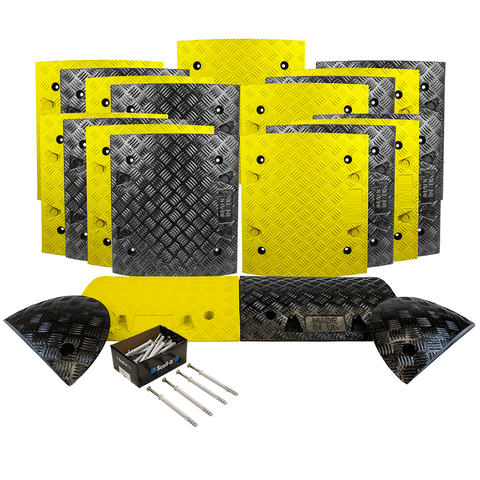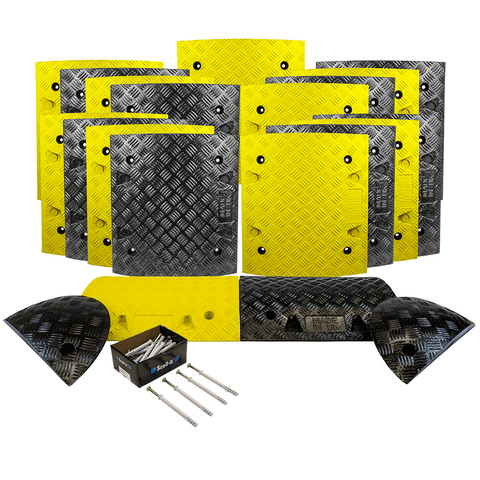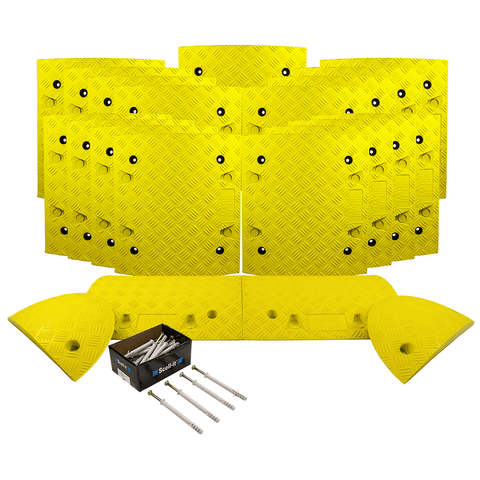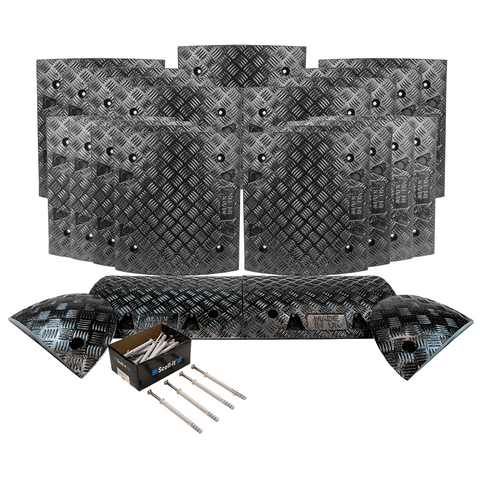Speed Bumps and Road Humps
At Street Solutions UK we offer an extensive range of speed ramps (speed cushion), speed bump kits and kerb ramp products to suit a variety of site tasks. Speed bump kits or speed bumps are popular traffic calming measures and wheel stops, they are mostly used around housing estates, shopping centres, construction sites, logistic and manufacturing sites, schools, and hospitals. The use of a speed cushion or parking post increases safety by slowing the flow of traffic in areas where there is a larger volume of pedestrian footfall.
Speed Bumps and Road Humps
We understand the importance of maintaining safer and slower traffic flow. That's why we offer a comprehensive collection of Speed Bumps designed to meet your road safety needs. Whether you're looking for permanent or temporary solutions, our regulation-compliant, heavy-duty, and non-slip speed bumps and speed ramp kits are built to last. Choose from our range of cost-effective and budget-friendly options, all designed to ensure optimal grip and performance for drivers and pedestrians alike. Shop our collection of Speed Bumps today and enjoy greater peace of mind knowing that you're investing in top-quality road safety products.
The heavy-duty ramps which we supply come with built-in cats’ eyes, to alert any road users of their presence in the dark. They come in two different sizes 50mm and 75mm, when they are bolted into position, they help enforce speed restrictions down to 10mph and 5mph (also works well with a cable protector and parking post). We manufacture the cushions using recycled PVC, ensuring they are eco-friendly and strong enough to withstand heavy good vehicles.
Our collection includes:
-
All Yellow Speed Bump Complete Kit 50mm - 10mph or 75mm - 5mph
-
All Black Speed Bump Complete Kit 50mm - 10mph or 75mm - 5mph
-
49cm Extra Wide Speed Bumps - End Caps
-
49cm Extra Wide Speed Bumps - Mid Section
-
Extra Wide Speed Bump Complete Kit 50mm - 10mph
Safety First: The Importance of Sleeping Policemen Speed Bumps
Navigating the roads of the UK, one is sure to encounter the ubiquitous 'sleeping policemen' - a casual term for speed bumps. At Street Solutions UK, we understand these sleeping policemen speed bumps' pivotal role in ensuring road safety. They're not merely humps in the road; they are strategically designed and placed to regulate traffic speed, especially in areas with high pedestrian activity or where children play.
Look no further if you're seeking the highest quality speed bumps for sale. Our sleeping policemen speed bumps are robust, durable, and designed to withstand the weight of heavy vehicles without deteriorating. Plus, they are made to the exacting standards required by UK regulations, ensuring they effectively calm traffic without causing unnecessary disruption.
Invest in the safety of your roads and communities with the trusted solutions from Street Solutions UK. Our commitment is to provide you with products that stand the test of time and traffic.
Speed Bumps vs. Speed Humps
Speed bumps and speed humps both reduce vehicle speed, but they differ in design and purpose. Speed bumps are more abrupt, requiring vehicles to slow almost to a stop, and are typically used in parking lots.
Speed humps are wider and less severe, allowing for smoother travel at lower speeds, commonly found in residential areas.
Detailed guide of Speed Bumps vs. Speed Humps
Speed Bump Regulations in the UK
In the UK, speed bumps must comply with specific speed bump regulations to ensure safety. They can be up to 100mm high and are typically placed in areas with a speed limit of 30 mph or less. Proper signage is required to warn drivers, and bumps must be spaced according to legal guidelines to prevent vehicle damage and ensure safe traffic flow.
Durable and High-Performance Bump Stops
Bump stops, also known as jounce bumpers, are important components used in the suspension system of a vehicle. They serve the function of hindering the plummeting of suspension, to protect vital components. Bump stops can absorb excessive energy when a vehicle hits a large bump, takes a hard corner, or passes through a pothole.
We offer high-performance and durable bump stops through our website, which are engineered to endure challenging conditions and deliver peak endurance, guaranteeing safe and comfortable conditions for your vehicle.
Why Choose Bump Stops for Safer Parking
Bump stops are among the most essential tools for instilling better safety standards at parking lots, loading bays and private roads. They are instrumental for preventing unwanted roll forward motion, keeping people, fences and other vehicles safe from probable accidents. At Street Solutions UK, we offer a wide selection of durable and premium-quality stops, crafted from heavy-duty recycled rubber. Our speed bumps can easily withstand repeated impact from passenger cars, vans and even HGVs.
Each of our bump stops is made with the utmost attention to detail and performance benchmarks. They can aid drivers during the day and night, with prominent bright yellow or reflective stripes. Our stops are weather-resistant and less susceptible to breaking or cracking, even in extreme conditions. Utilise them as a viable tool for keeping your high-traffic parking lots and yards safe.
Installing bump stops can prevent crashes, protect your infrastructure, and dynamically ramp up safety standards. It is a small investment that pays considerable dividends in terms of reducing liability and maintaining vehicle movement order.
Easy Installation and Long-Term Value with Premium Bump Stops
Our bump stops are easy to install in any location of your preference. They can be arranged in minutes, owing to precise tarmac or concrete fittings, and are easy to handle. They are suitable additions to any parking lot and instantly make spaces a lot safer. We stock bump stop variants to meet the needs of contractors, property owners and facility managers seeking efficient traffic-flow control solutions.
We provide bump stops that are designed to require the bare minimum of maintenance. With a sturdy modular rubber construction, these safety materials can withstand oil, gasoline and UV radiation. They last long even with heavy use, and do not spall or chap like their concrete counterparts. Apart from heavy-duty performance and reliability, these stops also give your space a professional and tidy appearance.
Street Solutions UK is a reliable provider of assorted and high-quality traffic control and safety equipment. Rely on us to get bump stops and other products at competitive rates, with fast and reliable shipping. If you need any assistance in picking the most suitable options, we can help. Get in touch with our experts for any assistance regarding type, length, colour, and other queries.
Explore our selection of bump stops and get the right ones for your needs. Express delivery and bulk discounts are available at checkout. For more information on our products or to get a custom quote on larger orders please get in touch with our sales team on 0161 706 0479 or email us at sales@streetsolutionsuk.com
Frequently Asked Questions (FAQs)
Q: Why rubber speed bumps are a smart choice?
A: Rubber speed bumps are durable, cost-effective, and easy to install. They offer flexibility for temporary or permanent use and are environmentally friendly, as many are made from recycled materials. Unlike asphalt or concrete, rubber versions are less prone to wear and can be easily removed or relocated when necessary.
Q: What are speed bump ramps used for?
A: Vertical traffic control management barriers such as speed bumps and speed humps are physical bumps in the road that startle the occupants of a vehicle travelling too quickly over them and offer great ground protection. Great to slow traffic and for road safety They are the most widely utilised traffic calming structural elements. Asphalt, concrete, plastic, rubber, and metal can all be used to create them.
Q: Is it against the law to drive around speed bumps?
A: A speed bump cannot be avoided. Even if there aren't any clearly delineated lanes. The entire speed bump must also be 12 feet long or more, according to the law. The "LOW SPOT" you're all talking about is for drainage, not two-wheelers.
Q: What are speed bumps used for?
A: Speed bumps are used to slow down vehicles and reduce their speed in areas where pedestrian or vehicular traffic is high. They are an effective way to improve safety and reduce the risk of accidents.
Q: What types of speed bumps do you offer?
A: We offer a variety of speed bumps, including rubber speed bumps, plastic speed bumps, and steel speed bumps. Our speed bumps are available in different sizes and designs to meet your specific needs.
Q: Are your speed bumps durable and weather-resistant?
A: Yes, our speed bumps are made of high-quality, durable materials that are designed to withstand harsh outdoor conditions. They are weather-resistant, UV-resistant, and can withstand heavy traffic and extreme temperatures.
Q: How easy are your speed bumps to install?
A: Our speed bumps are designed to be easy to install and can be installed by anyone with basic tools and DIY skills. They come with all the necessary hardware and instructions, and most can be installed in just a few hours.
Q: Are your speed bumps compliant with local regulations?
A: Yes, our speed bumps are designed to comply with local regulations for traffic calming measures. However, we recommend checking with your local authorities to ensure compliance with specific requirements.
Q: What is your return policy for speed bumps?
A: We offer a 30-day return policy for our speed bumps. If you are not satisfied with your purchase for any reason, you can return it for a full refund or exchange.
Q: What are speed bumps?
A: Speed bumps are traffic calming devices that are designed to slow down vehicles by creating a raised area on the road surface. They are typically made from rubber, asphalt or concrete, and are used to improve safety in areas where traffic speed needs to be reduced.
Q: How do speed bumps work?
A: Speed bumps work by forcing drivers to slow down and navigate over the raised area, which creates a discomfort or jolt that encourages them to reduce their speed. This makes them an effective traffic calming solution in areas where speeding is a problem.
Q: What are the benefits of speed bumps?
A: The main benefits of speed bumps are that they reduce vehicle speeds, improve safety for pedestrians and cyclists, and encourage drivers to be more cautious on the road. They can also be an effective way to reduce noise pollution and improve air quality in residential areas.
Q: Are speed bumps effective for reducing speed?
A: Yes, speed bumps are an effective way to reduce vehicle speeds, especially in areas where speeding is a problem. They are also useful for slowing down drivers in areas where pedestrians are present, such as near schools and residential areas.
Q: What types of speed bumps are available?
A: There are several types of speed bumps available, including rubber speed bumps, asphalt speed bumps, and concrete speed bumps. Each type has its own advantages and disadvantages, and the right choice will depend on your specific needs and budget.
Q: How do I install speed bumps?
A: The installation process for speed bumps will depend on the type of speed bump you choose, as well as the surface you are installing it on. For example, asphalt and concrete speed bumps require professional installation, while rubber speed bumps can be installed using adhesive or anchor bolts.
Q: Are speed bumps regulation compliant?
A: Yes, speed bumps are regulated by various federal, state, and local laws and regulations. It is important to ensure that any speed bumps you install are compliant with these regulations to avoid any legal issues.
Q: Can speed bumps damage my car?
A: Speed bumps can cause damage to vehicles if they are hit at high speeds or if the suspension is not in good condition. However, if drivers navigate over speed bumps at a reasonable speed, there should not be any damage to the vehicle.
Q: How do I choose the right speed bump for my needs?
A: To choose the right speed bump for your needs, you should consider factors such as traffic volume, vehicle speeds, and the type of road surface. You should also consider the material, size, and shape of the speed bump, as well as any specific regulations in your area.
Q: Are there any alternatives to speed bumps for traffic calming?
A: Yes, there are several alternatives to speed bumps for traffic calming, including speed cushions, chicanes, and roundabouts. The right choice will depend on the specific needs of your area, as well as your budget and other constraints.
Q: Can speed bumps be used in parking lots?
A: Yes, speed bumps can be used in parking lots to reduce speeds and improve safety for pedestrians and drivers. They are often used to control traffic flow and prevent accidents in high-traffic areas.
Q: Can speed bumps be used on private driveways?
A: Yes, speed bumps can be used on private driveways to improve safety and reduce speeds. However, it is important to ensure that any speed bumps you install are compliant with local regulations and do not create any hazards or damage to vehicles.
Q: How long do speed bumps last?
A: The lifespan of a speed bump will depend on several factors, including the material it is made from, the amount of traffic it sees, and the weather conditions in the area. Generally, rubber speed bumps can last up to 10 years, while asphalt and concrete speed bumps can last up to 20 years or more.
Q: How do I maintain speed bumps?
A: To maintain speed bumps, you should regularly inspect them for damage or wear and tear. You should also keep them clean and free of debris, and repair any damage as soon as possible to prevent further deterioration.
Q: Are there any safety concerns with speed bumps?
A: Speed bumps can create safety concerns if they are not installed properly or if they are hit at high speeds. However, if they are installed and maintained correctly, they can be a safe and effective way to slow down traffic and improve safety.
Q: Are speed bumps weather-resistant?
A: Yes, speed bumps are designed to be weather-resistant and can withstand a range of weather conditions, including rain, snow, and extreme temperatures. However, extreme weather conditions can cause damage to speed bumps over time.
Q: Can speed bumps be removed if necessary?
A: Yes, speed bumps can be removed if necessary, although the process will depend on the type of speed bump and the surface it is installed on. Professional removal may be necessary for asphalt and concrete speed bumps, while rubber speed bumps can be removed using adhesive remover or other tools.
Q: Are there any environmental concerns with speed bumps?
Q: What are bump stops, and why are they used?
A: Bump stops are low-profile barriers placed at parking spaces to prevent the forward rolling of vehicles. They offer adequate protection from accidental impact to walls, pathways, fences, and other vehicles.
Q: Where can bump stops be installed?
A: They can be installed in any car park, warehouse yard, loading bay, or driveway. Some of the most common areas of usage include fleet depots, residential complexes, car parks, and commercial premises where safety is a top priority.
Q: What materials are Street Solutions UK bump stops made from?
A: We stock stops crafted from high-strength recycled rubber. These are durable, withstand repeated impact, and are resistant to weather conditions. They are better alternatives to concrete stops and do not chip, decay, or crack.
Q: Are bump stops easy to install?
A: Yes. Each bump stop comes with the right fixings for tarmac or concrete surfaces. Installation is easy; most of the time, as they can be put in place in only a few minutes with standard supplies. This makes them great for rapid modifications to parking safety.
Q: Do bump stops require regular maintenance?
A: The high-quality stops listed on our platform do not need much care. They keep their form and strength for years since they are resistant to grease, gasoline, and UV rays. Maintenance tasks like checking the parts and cleaning up any dirt are usually all that's needed to keep them working at their best.





